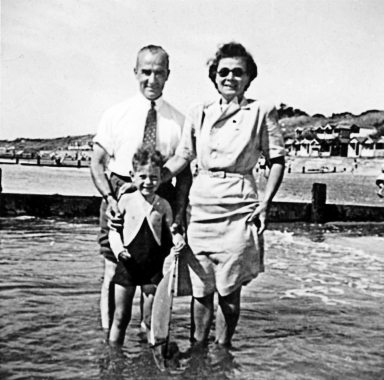Regard the photograph below. It was taken by my father with his Voigtländer Brillant camera. This model dated from 1932, and is a ‘box’ type camera, which looks a little like a twin-lens reflex, although the upper lens is used only for lining up the shot. Focus cannot be adjusted through it. The camera used 120 film, allowing 12 pictures (56mm x 56mm) per roll. The Brillant was made in Austria and was something of an improvement on the popular Kodak Brownie camera. It had three shutter speeds as well as B (Bulb) and T (Time) settings, could focus from 1.2m to infinity, and had aperture settings from f6.5 to f22.
This photograph was taken in the summer of 1950 on the beach at Frinton-on-Sea, which was where my family took all their holidays at that time. My father’s parents had lived in Frinton most of their lives, and still ran a toy shop in the centre of the little town.
The two adults in the picture were called Noël and Chloë, and I think were friends of the family. For convenience they were known to me and my sisters as ‘Uncle’ Noël and ‘Auntie’ Chloë. The small child holding the sailing boat is me, aged about 6 or 7.
The reproduction here is of course a digital scan from an old print, but in the 1950s film was processed by a photographic shop (or more often by a pharmacy) and returned to the customer in the form of contact prints, together with the original negatives. The negative of this particular photo has long been lost, and because of the muddle of my unsorted old albums and packets of unmounted prints I had thought the contact print was missing too. However, I have been having a clear-out this week and rather to my pleasure this photograph came to light once more. It is the only one I can find from that particular roll, although I do remember other, similar photos taken at the same time.
A close look at the photograph reveals a certain oddness. Uncle Noël is wearing a wristwatch on his right arm, whereas most people (both right- and left-handed) usually wear a watch on their left wrist. The dress that Auntie Chloë is wearing is buttoned with the left side over the right, while nearly all women’s clothes are buttoned the other way. And the small child, me, has a plaster cast on his right arm.
A few weeks before this holiday, I had been messing about in the garden at home, and had unwisely tried to climb a large pile of logs. The pile gave way, I plunged headfirst to the ground and in a moment of astonishing agony I broke my arm. It was a memorably traumatic incident — I had never before known such pain, and hope never to do so again. However, by the time of this holiday there was no need any more to wear a sling, and the plaster was due to be removed soon after we returned home. The holiday photographs came back from the chemist’s shop at about the same time as the plaster came off, and to my surprise they showed the plaster on the wrong arm. I knew for certain I had broken my left arm, not my right … as the photos appeared to reveal.
To the adult eye, the explanation is simple: for some reason, presumably accidental, the contact prints had been made with the negative reversed. But at age 7 I had no idea how photography worked, and although no doubt my father tried to explain it to me, no doubt I failed to understand. It was a significant mystery.
By the time I was a teenager I had become seriously interested in photography and was developing and printing my own pictures. I was no longer in any doubt about the method, and I had forgotten all about this incident. However, some thirty years later, in 1980, I did remember it all over again, and usefully so while I was writing.
 In Chapter 3 of my novel The Affirmation, the narrator, Peter Sinclair, describes a similar incident from his own youth. Trying to write an autobiographical account of himself Peter looks at old photos to check out details, and comes across a series of similarly anomalous reversed prints. The conclusion he draws from this (and my own intention in describing it in the novel) is how unreliable memory can sometimes be, and how even objective reality, a practical test of the past, is something you can’t always depend on. The Affirmation grew from that incident, and itself became a long elegy to the wonders of unreliability.
In Chapter 3 of my novel The Affirmation, the narrator, Peter Sinclair, describes a similar incident from his own youth. Trying to write an autobiographical account of himself Peter looks at old photos to check out details, and comes across a series of similarly anomalous reversed prints. The conclusion he draws from this (and my own intention in describing it in the novel) is how unreliable memory can sometimes be, and how even objective reality, a practical test of the past, is something you can’t always depend on. The Affirmation grew from that incident, and itself became a long elegy to the wonders of unreliability.
I am another three and half decades on from the writing of that novel, and at last I can find and reveal at least one of the photos that was behind it all. I still have my father’s Voigtländer camera. It is in full working order, and from time to time I take it out and think about trying to buy some film for it and seeing what it can do. Here it is today, taken with my much more up-to-date Japanese camera:

